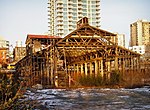First Church of Christ, Scientist (North Vancouver)
The former First Church of Christ, Scientist is an historic Christian Science church edifice located at 189 Keith Road on the eastern end of Victoria Park in North Vancouver, British Columbia, Canada. It was designed in the Classical Revival style by the noted British Columbia architectural firm of Honeyman and Curtis. Built in 1925, it is a single-storey wooden building with basement. The city of North Vancouver has declared that the building is "valued for its architecture and classically-inspired details" and "distinguished by a formal central entrance and consistent, refined detailing". Saying that its: "Columns, symmetry and fenestration all contribute to its strong sense of proportion and formality", the city on January 1, 1995, designated it a primary local heritage site.On January 4, 2008, First Church of Christ, Scientist sold its building to North Shore Bethel Christian Mennonite Brethren Church.
Excerpt from the Wikipedia article First Church of Christ, Scientist (North Vancouver) (License: CC BY-SA 3.0, Authors).First Church of Christ, Scientist (North Vancouver)
East Keith Road, North Vancouver Lower Lonsdale
Geographical coordinates (GPS) Address Nearby Places Show on map
Geographical coordinates (GPS)
| Latitude | Longitude |
|---|---|
| N 49.3155 ° | E -123.0711 ° |
Address
East Keith Road 185
V7M 2H3 North Vancouver, Lower Lonsdale
British Columbia, Canada
Open on Google Maps





